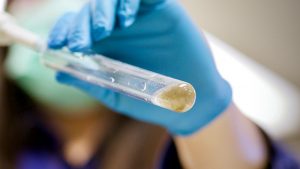
Making bioplastics from sewage sludge and wastewater
Canadian Plastics
Research & Development SustainabilityResearchers at Texas A&M University have discovered a salt-tolerant bacteria with an appetite for sludge that can make biodegradable plastics.

Zobellella denitrificans ZD1 bacteria feed on sludge to make biodegradable plastics. Photo Credit: Kung-Hui (Bella) Chu/Texas A&M University
Not many people would equate sewage sludge with plastics, but researchers at Texas A&M University, in College Station, Tex., have – and in a new study, they’ve uncovered an efficient way to use leftover sludge to make biodegradable plastics.
As reported by Texas A&M Today, and elaborated on in the September issue of the journal American Chemical Society (ACS) Omega, the researchers have shown that the bacterium Zobellella denitrificans ZD1, found in mangroves, can consume sludge and wastewater to produce polyhydroxybutyrate, a type of biopolymer that can be used instead of petroleum-based plastics. In addition to cutting down the amount of sludge going to waste in landfills, the researchers said that Zobellella denitrificans ZD1 offers a way to make bioplastics more competitively priced against regular plastics by reducing upstream costs.
“The price of raw materials to cultivate biopolymer-producing bacteria accounts for 25-45% of the total production cost of manufacturing bioplastics. Certainly, this cost can be greatly reduced if we can tap into an alternate resource that is cheaper and readily obtainable,” said Dr. Kung-Hui (Bella) Chu, professor in the Zachry Department of Civil and Environmental Engineering. “We have demonstrated a potential way to use municipal wastewater-activated sludge and agri- and aqua-culture industrial wastewater to make biodegradable plastics. Furthermore, the bacterial strain does not require elaborate sterilization processes to prevent contamination from other microbes, further cutting down operating and production costs of bioplastics.”
The polyhydroxybutyrate class of bioplastics is made by several bacterial species when they experience an imbalance of nutrients in their environment when other common energy sources aren’t available, and acts as the bacteria’s supplemental energy reserves, similar to fat deposits in humans. One such medium that can force bacteria to make polyhydroxybutyrate is crude glycerol, which is a byproduct of biodiesel manufacturing – crude glycerol is rich in carbon and has no nitrogen, making it a suitable raw material for making bioplastics. The problem is, crude glycerol contains impurities such as fatty acids, salts and methanol, which can prohibit bacterial growth. Like crude glycerol, sludge from wastewater also has many of the same fatty acids and salts.
The effects of these fatty acids on bacterial growth and, consequently, polyhydroxybutyrate production had not yet been examined, Chu said. “There is a multitude of bacterial species that make polyhydroxybutyrate, but only a few that can survive in high-salt environments and even fewer among those strains can produce polyhydroxybutyrate from pure glycerol,” she said. “We looked at the possibility of whether these salt-tolerating strains can also grow on crude glycerol and wastewater.”
For their study, Chu and her team chose the Zobellella denitrificans ZD1 – whose natural habitat is the salt waters of the mangroves – and then tested the growth and the ability of this bacteria to produce polyhydroxybutyrate in pure glycerol; and then also repeated the same experiments with other bacterial strains that are known producers of polyhydroxybutyrate. They found that Zobellella denitrificans DZ1 was able to thrive in pure glycerol and produced the maximum amount of polyhydroxybutyrate in proportion to its dry weight (its weight without water).
Next, they tested the growth and ability of Zobellella denitrificans ZD1 to produce polyhydroxybutyrate in glycerol containing salt and fatty acids and found that even in these conditions, it produced polyhydroxybutyrate efficiently, even under balanced nutrient conditions. When they repeated the experiments in samples of high-strength synthetic wastewater and wastewater-activated sludge, they found the bacteria was still able to make polyhydroxybutyrate, although at lower quantities than if they were in crude glycerol.
Chu also noted that leveraging Zobellella denitrificans ZD1 tolerance for salty environments avoids the expensive sterilization processes that are normally needed when working with other strains of bacteria. “Zobellella denitrificans ZD1 natural preference for salinity is fantastic because we can, if needed, tweak the chemical composition of the waste by just adding common salts. This environment would be toxic for other strains of bacteria,” she said. “So, we are offering a low-cost, sustainable method to make bioplastics and another way to repurpose biowastes that are costly to dispose of.”
Other contributors to this research include Fahad Asiri, Chih-Hung Chen, Myung Hwangbo, and Yiru Shao from the civil and environmental engineering department at Texas A&M.
Source: Texas A&M University
